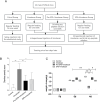Modulation of gut microbiota and immune response by soy peptides mitigates irinotecan induced intestinal toxicity
- PMID: 40529994
- PMCID: PMC12170514
- DOI: 10.3389/fphys.2025.1538733
Modulation of gut microbiota and immune response by soy peptides mitigates irinotecan induced intestinal toxicity
Abstract
Introduction: Irinotecan (CPT-11), a cornerstone chemotherapeutic agent for colorectal and pancreatic cancers, is limited by severe gastrointestinal toxicities, particularly diarrhea, which compromises treatment adherence and patient quality of life. Soy peptides (SPs), bioactive compounds with anti-inflammatory and prebiotic properties, have shown potential in enhancing intestinal barrier function. This study investigates SPs' protective effects against irinotecan-induced intestinal injury, focusing on microbiota modulation, immune regulation, and mucosal repair.
Methods: Female C57BL/6 mice were randomly divided into four groups (n = 10/group): Control, Irinotecan, Pre-SPs+ Irinotecan, and SPs+ Irinotecan. Diarrhea severity and body weight changes were monitored daily. Small intestinal injury was evaluated by hematoxylin and eosin (H&E) staining with epithelial damage scoring, while intestinal barrier integrity was assessed via Western blotting (WB) and immunohistochemistry. Serum levels of inflammatory cytokines (TNF-α and IL-6) were quantified using ELISA, and neutrophil infiltration was measured by flow cytometry. Fecal samples were subjected to 16S rRNA sequencing to analyze gut microbiota composition.
Results: SPs intervention significantly reduced the incidence of diarrhea (P < 0.05) and attenuated body weight loss (P < 0.05) in mice. Histological analysis demonstrated that SPs restored intestinal architecture, as evidenced by reduced epithelial damage scores (P < 0.05), increased expression of tight junction proteins (occludin and ZO-1), and improved intestinal permeability (P < 0.05). Gut microbiota profiling revealed that irinotecan-induced dysbiosis was characterized by decreased α-diversity and enrichment of pathogenic taxa. SPs treatment restored microbial diversity and significantly elevated the abundance of beneficial genera, including Lactobacillus and Bifidobacterium (P < 0.05). Immunological assays further indicated that SPs suppressed pro-inflammatory cytokine levels (TNF-α and IL-6, P < 0.001) and reduced neutrophil infiltration (P < 0.05).
Discussion: These findings suggest that soy peptides protect against irinotecan-induced intestinal toxicity through multiple mechanisms, including microbiota regulation, immune modulation, and intestinal barrier restoration, highlighting their potential as a therapeutic candidate for chemotherapy-induced intestinal damage.
Keywords: diarrhea; gut microbiota; immune modulation; intestinal damage; irinotecan; soy peptides.
Copyright © 2025 Jing and Yan.
Conflict of interest statement
The soy peptides used in this study are provided by Hebei Runkang Medical Technology Co., Ltd., and may be related to the company's product development.
Figures







Similar articles
-
Brusatol ameliorates irinotecan-induced delayed diarrhea via inhibition of the cGAS-STING pathway and modulation of intestinal flora.Phytomedicine. 2025 Sep;145:157071. doi: 10.1016/j.phymed.2025.157071. Epub 2025 Jul 11. Phytomedicine. 2025. PMID: 40684488
-
Limosilactobacillus reuteri prevents progression of ankylosing spondylitis in mice by restoring gut microbiota-metabolism homeostasis.J Transl Med. 2025 Jul 1;23(1):715. doi: 10.1186/s12967-025-06681-2. J Transl Med. 2025. PMID: 40598252 Free PMC article.
-
Lyophyllum decastes-derived polysaccharides alleviate DSS-induced colitis in mice by suppressing inflammation, enhancing intestinal barrier integrity, and restoring gut microbiota homeostasis.Front Pharmacol. 2025 Jul 11;16:1644325. doi: 10.3389/fphar.2025.1644325. eCollection 2025. Front Pharmacol. 2025. PMID: 40717964 Free PMC article.
-
Radiation-induced injury and the gut microbiota: insights from a microbial perspective.Therap Adv Gastroenterol. 2025 Jun 16;18:17562848251347347. doi: 10.1177/17562848251347347. eCollection 2025. Therap Adv Gastroenterol. 2025. PMID: 40535532 Free PMC article. Review.
-
Immune dysregulation in ulcerative colitis: pathogenic mechanisms and therapeutic strategies of traditional Chinese medicine.Front Cell Dev Biol. 2025 Jun 5;13:1610435. doi: 10.3389/fcell.2025.1610435. eCollection 2025. Front Cell Dev Biol. 2025. PMID: 40538978 Free PMC article. Review.
References
-
- Arifa R. D. N., Paula T. P. d., Madeira M. F. M., Lima R. L., Garcia Z. M., Ÿvila T. V., et al. (2016). The reduction of oxidative stress by nanocomposite Fullerol decreases mucositis severity and reverts leukopenia induced by Irinotecan. Pharmacol. Res. 107, 102–110. 10.1016/j.phrs.2016.03.004 - DOI - PubMed
LinkOut - more resources
Full Text Sources

